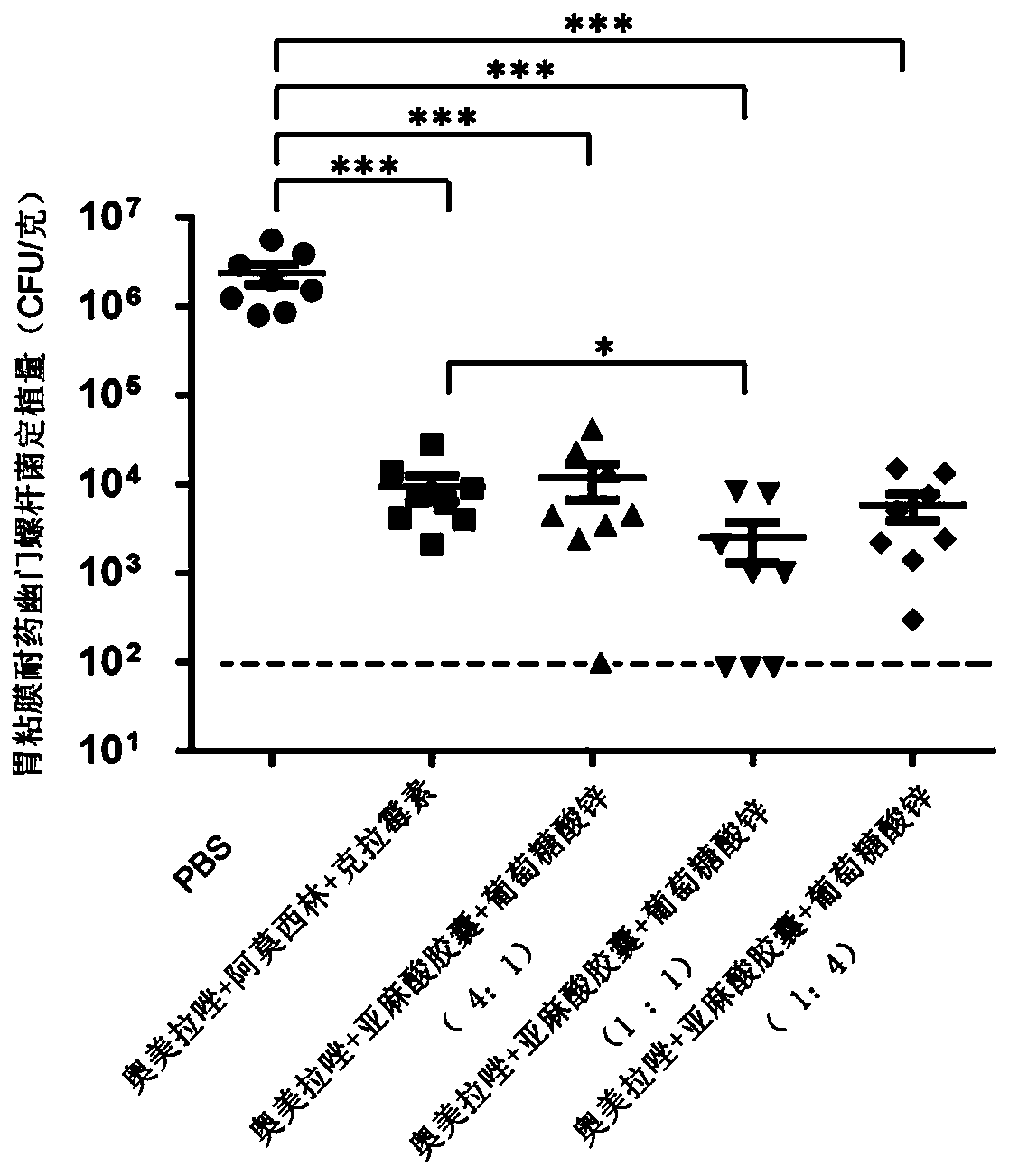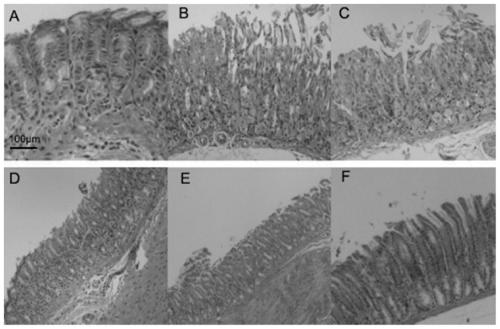Composition for resisting helicobacter pylori and application thereof
A technology of anti-helicobacter pylori and composition, which is applied in the field of medicine, can solve the problems of the same drug administration method and related medical effects, etc., to alleviate the problem of drug resistance of helicobacter pylori, with small toxic and side effects and low medical expenses Effect
- Summary
- Abstract
- Description
- Claims
- Application Information
AI Technical Summary
Problems solved by technology
Method used
Image
Examples
Embodiment 1
[0018] First, antibacterial in vitro: Zinc and linolenic acid are used in combination according to the molar concentration ratio of 4:1, and the minimum inhibitory concentration of zinc gluconate oral liquid and linolenic acid capsules for drug-resistant and sensitive Helicobacter pylori is 16- 32μg / mL, polyprezinc combined with linolenic acid capsules is 16-64μg / mL.
[0019] Second, in vivo treatment: The drug combination is linolenic acid capsules, zinc preparations and omeprazole. Helicobacter pylori was used to infect mice to establish an acute gastritis model, and gastritis mice were administered intragastrically once a day for 5 consecutive days. Wherein zinc and linolenic acid are used according to the molar concentration ratio of 4:1. The daily dosage includes omeprazole 138.2mg / kg, zinc gluconate oral solution or polyprezinc 13.5mg / kg (calculated based on zinc content), linolenic acid capsule 14.5mg / kg (calculated based on linolenic acid content) . Helicobacter pylo...
Embodiment 2
[0021] First, antibacterial in vitro: zinc and linolenic acid are used in combination according to the molar concentration ratio of 1:1, and the minimum inhibitory concentration of zinc gluconate oral liquid and linolenic acid capsules for drug-resistant and sensitive Helicobacter pylori is 8- 16μg / mL, polyprezinc combined with linolenic acid capsules is 16~64μg / mL.
[0022] Second, in vivo treatment: The drug combination is linolenic acid capsules, zinc preparations and omeprazole. Helicobacter pylori was used to infect mice to establish an acute gastritis model, and gastritis mice were administered intragastrically once a day for 5 consecutive days. Among them, zinc and linolenic acid are used according to the molar concentration ratio of 1:1. Daily dosage includes omeprazole 138.2mg / kg, zinc gluconate oral solution or polyprezinc 5.3mg / kg (calculated based on zinc content), linolenic acid capsule 22.7mg / kg (calculated based on linolenic acid content) . Helicobacter pylori...
Embodiment 3
[0024] First, in vitro bacteriostasis: Zinc and linolenic acid are used in combination according to the molar concentration ratio of 1:4, zinc gluconate oral liquid (or polyprezinc) and linolenic acid capsules are used in combination on drug-resistant and sensitive Helicobacter pylori. The minimum inhibitory concentration was 16-64μg / mL.
[0025] Second, in vivo treatment: The drug combination is linolenic acid capsules, zinc preparations and omeprazole. Helicobacter pylori was used to infect mice to establish an acute gastritis model, and gastritis mice were administered intragastrically once a day for 5 consecutive days. Among them, zinc and linolenic acid are used according to the molar concentration ratio of 1:4. Daily dosage includes omeprazole 138.2mg / kg, zinc gluconate oral solution or polyprezinc 1.6mg / kg (calculated based on zinc content), linolenic acid capsule 26.4mg / kg (calculated based on linolenic acid content) . Helicobacter pylori colonization in mice decreas...
PUM
 Login to View More
Login to View More Abstract
Description
Claims
Application Information
 Login to View More
Login to View More - R&D
- Intellectual Property
- Life Sciences
- Materials
- Tech Scout
- Unparalleled Data Quality
- Higher Quality Content
- 60% Fewer Hallucinations
Browse by: Latest US Patents, China's latest patents, Technical Efficacy Thesaurus, Application Domain, Technology Topic, Popular Technical Reports.
© 2025 PatSnap. All rights reserved.Legal|Privacy policy|Modern Slavery Act Transparency Statement|Sitemap|About US| Contact US: help@patsnap.com



